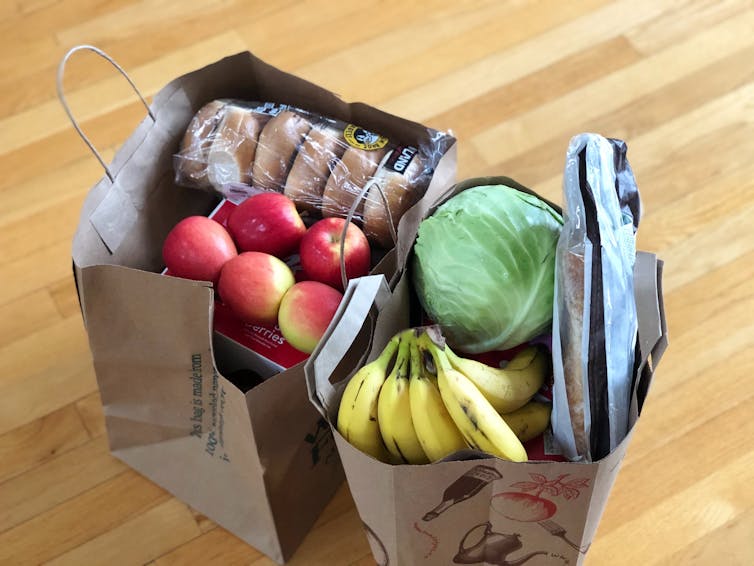Source: The Conversation (Au and NZ) – By Emily Burch, Dietitian & Academic, Southern Cross University

A rise in the cost of living has led many households to look for ways to save money.
New research suggests maintaining a healthy diet, in line with the Australian Dietary Guidelines, is cheaper than an unhealthy diet and could save A$160 off a family of four’s fortnightly shopping bill.
Poor diet is the most common preventable risk factor contributing to chronic disease in Australia. So improving your diet can also be an important way to reduce the chance of developing chronic disease.
Read more:
Yes, $5 for lettuce is too much. Government should act to stem the rising cost of healthy eating
First, what are the dietary guidelines?
The guidelines provide information on the quantity and types of foods most Australians should consume to promote overall health and wellbeing.
Recommendations include eating a wide variety of nutritious foods from the main five food groups:
- vegetables and legumes
- fruit
- grains
- lean meats and meat alternatives such as tofu, nuts and legumes
- dairy products.
The guidelines recommend limiting our intake of foods high in saturated fat, added salt, added sugars and alcohol.
What are Australians eating?
Fewer than 7% of Australians eat sufficient vegetables, in line with the Australian Dietary Guidelines. In fact, Australians have an average healthy diet score of 55 out of 100 – barely passing.
Foods that aren’t part of a food group are known as “discretionary” items, which includes alcohol, cakes, biscuits, chocolate and confectionery and most takeaway foods. Because they’re typically high in kilojoules, saturated fat, sodium and added sugars, the Australian Dietary Guidelines recommend they only be eaten occasionally and in small amounts (ideally zero serves).
For many households, discretionary items make up a big portion of their grocery shop. Australians consume an average of 28 serves of discretionary choices per week (equal to 28 doughnuts, 28 slices of cake, or 28 cans of soft drink or beer). This is an increase of ten serves since 2015.
One recent study estimated 55% of Australians’ total energy intake was from discretionary items.
What did the researchers find?
Researchers from the Health Promotion Team at South West Healthcare recently visited four local supermarkets and takeaway stores in Warrnambool, Victoria, and purchased two baskets of groceries.
One basket met the Australian Dietary Guidelines (basket one), the other aligned with the typical dietary intake of Australians (basket two).
They compared prices between the two and found basket one would cost approximately $167 less per fortnight for a family of four at the most affordable supermarket. That’s equal to $4,342 a year.
Basket one was sufficient to supply a family of four for a fortnight, and aligned with the Australian Dietary Guidelines. It cost $724 and included:
- fruit and vegetables (made up 31% of the fortnightly shop)
- grains and cereals (oats, cornflakes, bread, rice, pasta, Weet-bix)
- lean meats and alternatives (mince, steak, chicken, tuna, eggs, nuts)
- milk, yoghurt and cheese
- oils and spreads (olive oil).

Maria Lin Kim/Unpslash
Basket two reflected the current average Australian fortnightly shop for a family of four.
In the project, the team spent over half of the fortnightly shop on processed and packaged foods, of which 21% was spent on take-away. This is based on actual dietary intake of the general population reported in the 2011-2012 Australian Health Survey.
Basket two cost $891 and included:
- fruit and vegetables (made up 13% of the fortnightly shop)
- grains and cereals (oats, cornflakes, bread, rice, pasta, Weet-bix)
- lean meats and alternatives (mince, steak, chicken, tuna, eggs, nuts)
- milk, yogurt and cheese
- oils and spreads (olive oil, butter)
- drinks (soft drink, fruit juice)
- desserts and snacks (muffins, sweet biscuits, chocolate, ice cream, potato chips, muesli bars)
- processed meats (sausages, ham)
- convenience meals
- fast food (pizza, meat pie, hamburger, fish and chips)
- alcohol (beer, wine).
Read more:
Are home-brand foods healthy? If you read the label, you may be pleasantly surprised
But a healthy basket is still unaffordable for many
While this piece of work, and other research, suggests a healthy diet is less expensive than an unhealthy diet, affordability is still a challenge for many families.
The Warrnambool research found basket one (which aligned with guidelines) was still costly, requiring approximately 25% of a median household income.
This is unaffordable for many. For a household reliant on welfare, basket one would require allocating 26%-38% of their income. This highlights how the rising cost of living crisis is affecting those already facing financial difficulties.

Ann Nguyen/Unsplash
Around 3.7 million Australian households did not have access to enough food to meet their basic needs at some point in the last 12 months.
Policy action is needed from the Australian government to make recommended diets more affordable for low socioeconomic groups. This means lowering the costs of healthy foods and ensuring household incomes are sufficient.
What else can you do to cut your spending?
To help reduce food costs and support your health, reducing discretionary foods could be a good idea.
Other ways to reduce your grocery bill and keep your food healthy and fresh include:
-
planning for some meatless meals each week. Pulses (beans, lentils and legumes) are nutritious and cheap (a can is less than $1.50. Here are some great pulse recipes to try
-
checking the specials and buy in bulk (to store or freeze) when items are cheaper
-
making big batches of meals and freezing them. Single-serve portions can help save time for lunches at work, saving on takeaway
-
Australian supermarkets are almost never the cheapest place for fresh produce, so shop around for farmers markets or smaller local grocery shops
-
buying generic brands when possible, as they are notably cheaper. Supermarkets usually promote the items they want you to buy at eye-level, so check the shelves above and below for cheaper alternatives.
Read more:
Bring a plate! What to take to Christmas lunch that looks impressive (but won’t break the bank)
![]()
Emily Burch works for Southern Cross University.
Lauren Ball works for The University of Queensland and receives funding from the National Health and Medical Research Council, Queensland Health, Mater Misericordia and the Royal Australian College of General Practitioners. She is a Director of Dietitians Australia, a Director of the Darling Downs and West Moreton Primary Health Network and an Associate Member of the Australian Academy of Health and Medical Sciences.
– ref. Trying to spend less on food? Following the dietary guidelines might save you $160 a fortnight – https://theconversation.com/trying-to-spend-less-on-food-following-the-dietary-guidelines-might-save-you-160-a-fortnight-216749








